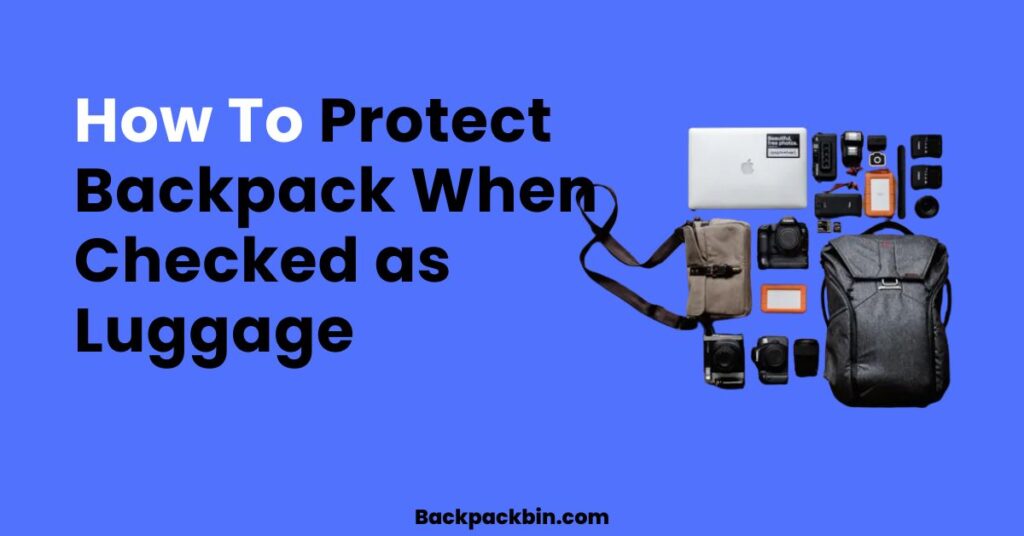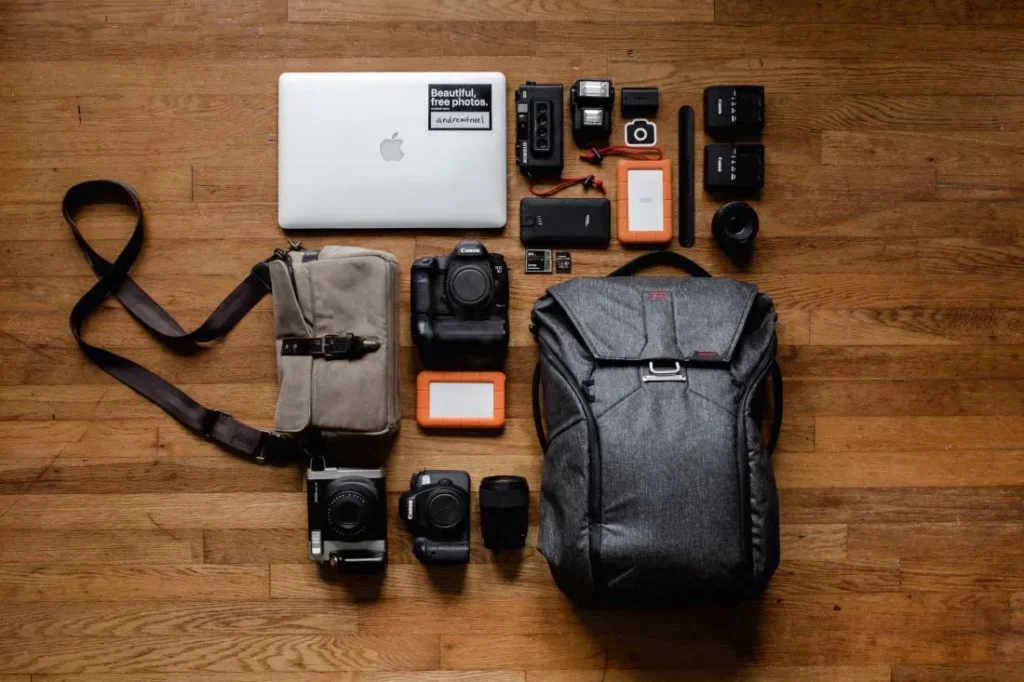How To Protect Backpack When Checked as Luggage [4 Easy Steps]

As any frequent traveler will say, the biggest problem about traveling via air is not knowing how to protect your backpack when checked as luggage. Despite trying all the measures, it can cause some major inconveniences if not done correctly.
If there is anything better than a good backpack on a comfortable flight, then it is that backpack checked in as your flight luggage, and no additional burden of carry-on! With your backpack checked in, you are saved from the hassle of carrying multiple backpacks and suitcases and having to juggle all of them.
But the flip side to that convenience is that all your things are in one place away from your watchful eyes. This can lead to some highly unfavorable situations such as the breaking of items, theft or mishandling, etc. To save you from that trouble, we bring you a thorough guide on how to protect your backpack when checked as luggage.
Choosing the Right Backpack:

Well first things first, to have a safe and steady flight, you need the right backpack that will require you to do minimal effort. On the contrary, a backpack bought in haste that comes with the wrong amount of storage space and material is only going to cause hindrances in your flight. Here are some things that you should keep in mind when you get the backpack.
A. Durability and Resilience:
There is no doubt in the fact that a backpack that can withstand the test of flight is a backpack that will be durable enough for your life.
The luggage is usually transported in a hasty manner and if your backpack is not sturdy enough, chances are that it might get damaged during the luggage transport. Try and search for backpacks that suit your style and durability criteria this way.
B. Backpack lock or Closure Mechanism:
Another huge issue you are likely to face during your flight is the important things that you have in your backpack can get lost easily in all the haste, or worse, they can be stolen.
A good way to prevent all this is to buy a backpack that has a built-in anti-theft lock or closure mechanism for two main things.
Firstly to keep the material from getting misplaced due to a half-open bag and secondly to protect it from potential swipers. If you are a woman, we are sure you will love our suggestions on some Best stylish anti-theft backpacks for ladies.
C. Number of Compartments:
The greater number of functional compartments gives more organization to your luggage and in turn more protection so consider that in your next backpack.
Preparing Your Backpack for Check-In:

Now that you have decided on a good backpack that will be your partner, there are some things you will need to consider before you embark on that flight. A well-prepared backpack can be heavenly luggage for you and make your flight much easier. Follow the following tips to prepare a good backpack for luggage.
A. Decluttering your backpack:
We know how tempting it is to take everything with you that you may find helpful on your trips. Especially when you are traveling for the first time and don’t know what you will be needing exactly.
Despite that, we suggest that you do some research and plan so that you are fully aware of what you need. Choose the things you don’t need and remove them from the backpack. Trust us, this will be a great improvement to your luggage planning.
B. Securing loose straps and accessories:
After you are done selecting the things that you need in the right backpack, it’s important that you secure the backpack altogether so that it may not untie easily.
It is here that you will benefit highly from an anti-theft backpack, but even if you don’t have one, make sure you secure all the straps, maybe add an extra ribbon or two so that the zipper remains closed under any conditions.
C. Protecting fragile items with appropriate padding or wrapping:
Any fragile items that may break, should be kept in a separate compartment as well as wrapped in proper paddings so that they are not broken.
Never forget this rule when you are packing anything that can break easily (although it’s best that you keep all fragile valuables closer to you).
Packing Strategies for Backpack Protection:
We are aware of all the hassles of having to pack a backpack for your trip so the tips do not end in following the correct way. Here are also some strategies that you can follow to keep it easier for you.
A. Positioning heavy and sturdy items at the bottom:
It will allow the weight to be evenly distributed both while you are carrying it and while it is being shipped as luggage. This ensures that the heavier items do not crush or break the smaller items and both are well protected.
B. Utilizing packing cubes or compression bags for organization and protection:
You have no idea what lifesaver compression bags are until you’ve used one. These will create more useful space which was otherwise taken by uncompressed clothes or other materials. So, use them whenever necessary.
C. Placing breakable items in the center, surrounded by soft materials:
Even though using paddings and wrappings is a compulsory measure, one thing you can do extra to keep the fragile items in your backpack protected in the luggage is setting up your backpack in such a way that those fragile things are surrounded by soft material. This will keep them more secure.
D. Using a backpack rain cover to protect against water damage:
One pro tip that is going to save you many times during your trip is to always keep a rain cover even when it’s not raining. This will protect your backpack if it gets wet due to some shipping mishap.
E. Being aware of liquids:
If you are carrying any liquid example shampoo or juice box etc., be extra careful as the pressure changes in the airplane can cause the bottles to explode.
Try to avoid carrying liquids but if you must, make sure the container is completely sealed and packed in multiple layers. If kept in a separate compartment that will make things easier for you.
What to do at the Airport:
Following are some of the steps that you should do at the Airport.
Proper Labeling and Identification:
As you are taking the backpack to the airport make sure that you do measures to keep the backpack under check. There are times when whole backpacks are lost at the airport because they aren’t easily identifiable. Always add external and internal identification tags for easy backpack recognition.
In this aspect, buying a backpack that has a unique design might help but the best way is to have proper non-removable tags that can help you easily identify the backpack. You can also include your contact information and destination details inside the backpack so that the authorities can contact you once they find the backpack.
This will save you from a lot of trouble at the airport. One last resort that is something you should not forget is photographing the backpack’s appearance and contents. This can enable you to provide proof of your backpack if it is lost or stolen and can also help the staff appointed to help you.
Communication with Airline Staff:
As you prepare your backpack for the flight, it is also important that you inform the staff about the backpack as well in case it needs some special protection.
You can easily ask about the handling of sensitive valuables and what is the protocol for them. You can also tell them about your luggage and if you need any extra measures to protect it.
Lastly, you can ask for their facilitation during the flight and request them to inform you about the whereabouts of your luggage. Don’t hesitate, they will be happy to do that for you!
Handling Baggage Mishaps:
Sometimes, even after all the efforts and planning, things don’t always go our way and you can nonetheless face some problems with the backpack.
It is during this condition that you have to be patient and alert so to minimize your damage. The first thing you should do is to immediately report any damage or missing items as soon as you find out upon landing.
This is where your photographs of the content before boarding will help you as you can present them for your claim. You should then follow up with the airlines regarding compensation or repair options as soon as possible. Even though this might not bring your damaged item back, the compensation can turn out to be very good at times!
Conclusion:
We are sure you got a good enough idea of how to protect your backpack when checked as luggage and why is it important. If you follow these tips and invest in a good backpack and put, just a little bit of planning into buying it and then packing it for luggage check-in at the airport, you can have a smooth flight without any chaos.
If you are looking for good options of bags to carry to the airport, you can check up our blog’s best stylish female backpacks for traveling. If you find the right backpack there, then you can definitely ease down your flight as you wish!
FAQs:
Is It safe to put backpack in a checked luggage?
With appropriate precautions and planning, putting a backpack in checked luggage is absolutely safe and nothing to worry about.
Do checked backpacks get damaged?
Usually, normal wear and tear especially in the case of absolutely brand new backpacks is common but more than that properly backed checked backpacks do not get damaged.
What is the best way to pack a backpack for safe travel?
The best way to pack a backpack for safe travel is to distribute the weight evenly in such a manner that the heaviest stuff is at the bottom followed by middle-weight stuff and then lightweight things. The liquids should be properly sealed and the bag strapped properly. In this way, the backpack will be safe.
What to avoid in checked-in baggage to keep it protected?
To keep your baggage protected, do not put unsealed liquids or unprotected sharp objects in the backpack. Avoid throwing them in the check-in area to keep things safe.
Should I wrap my backpack at the airport?
By wrapping your backpack in a plastic bag or protective material, you can minimize the effects of tear and damage on the backpack so it is advisable that you wrap your backpack.


